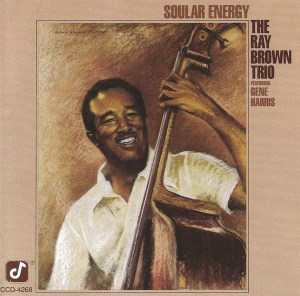
This Concord Jazz LP has excellent sound.
There is also a half-speed mastered audiophile version of this record cut by Stan Ricker himself.
Now hold on: half-speed mastering by its very nature causes a dramatic loss of bass definition, not to mention the fact that much of the deep bass usually goes completely missing. This is a record built around the sound of Ray Brown’s double bass. Do you really want the lowest octave of bass to disappear and the bass above it to turn to mud on a record that features a bass player as its leader? It’s crazy, right?
I’ve never heard the half-speed and don’t plan to track one down in order to audition it, but I guarantee you that this “full-speed” mastered version will blow the doors off any version mastered by Stan Ricker.
There is plenty of commentary on the website about his incompetent mastering and I recommend you take a moment to read some of it before you buy any half-speed mastered record. (We of course do not offer such records, with the exception of John Klemmer’s Touch, which is a half-speed mastered record that actually does sound good, superb in fact.)
AMG Review
This album is important as an early milestone in pianist Gene Harris’ second career. Harris, who had led the popular Three Sounds in the 1960s, had been living in obscurity in Boise, ID, for several years before he was urged by bassist Ray Brown to come to the West Coast for some recording sessions. Harris became a permanent member of Brown’s regular trio for quite a few years before launching his own quartet. He had lost none of his technique, soul, or swing in the interim, as he shows throughout this fine release. Seven of the eight numbers (highlighted by “Exactly Like You,” “Teach Me Tonight,” and “Sweet Georgia Brown”) feature Brown, Harris, and drummer Gerry King playing soulful bop, while “Mistreated But Undefeated Blues” adds guitarist Emily Remler and the tenor of Red Holloway. An excellent effort.
This is an Older Jazz Review.
Most of the older reviews you see are for records that did not go through the shootout process, the revolutionary approach to finding better sounding pressings we developed in the early 2000s and have since turned into a fine art.
We found the records you see in these older listings by cleaning and playing a pressing or two of the album, which we then described and priced based on how good the sound and surfaces were. (For out Hot Stamper listings, the Sonic Grades and Vinyl Playgrades are listed separately.)
We were often wrong back in those days, something we have no reason to hide. Audio equipment and record cleaning technologies have come a long way since those darker days, a subject we discuss here.
Currently, 99% (or more!) of the records we sell are cleaned, then auditioned under rigorously controlled conditions, up against a number of other pressings. We award them sonic grades, and then condition check them for surface noise.
As you may imagine, this approach requires a great deal of time, effort and skill, which is why we currently have a highly trained staff of about ten. No individual or business without the aid of such a committed group could possibly dig as deep into the sound of records as we have, and it is unlikely that anyone besides us could ever come along to do the kind of work we do.
The term “Hot Stampers” gets thrown around a lot these days, but to us it means only one thing: a record that has been through the shootout process and found to be of exceptionally high quality.
The result of our labor is the hundreds of titles seen here, every one of which is unique and guaranteed to be the best sounding copy of the album you have ever heard or you get your money back.
Helpful Advice on Cleaning Your Records